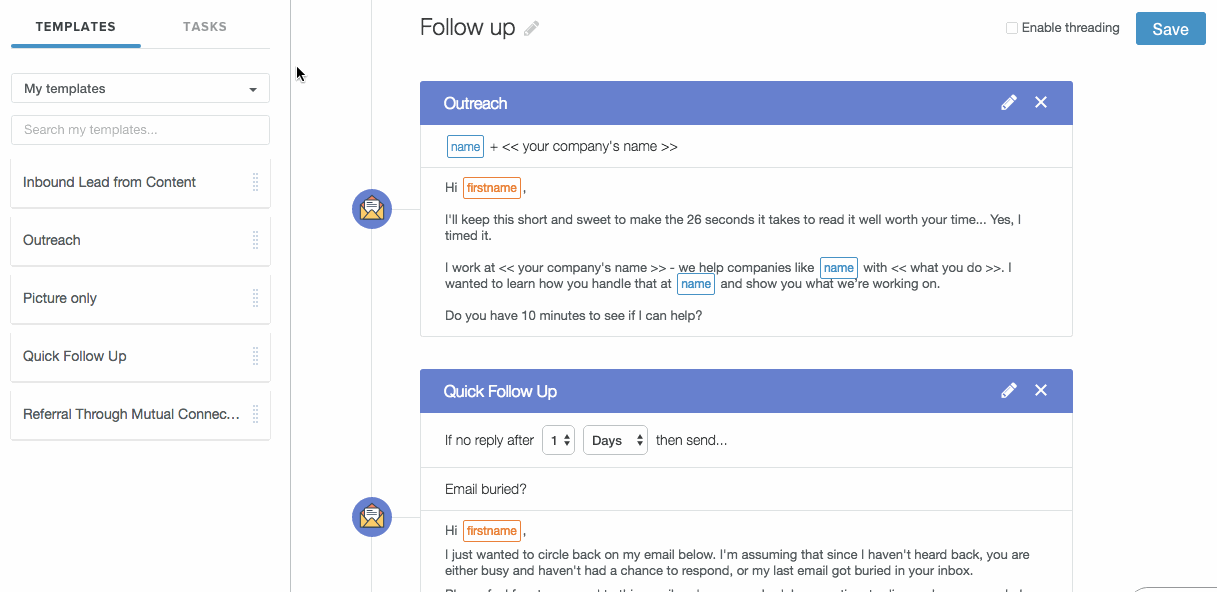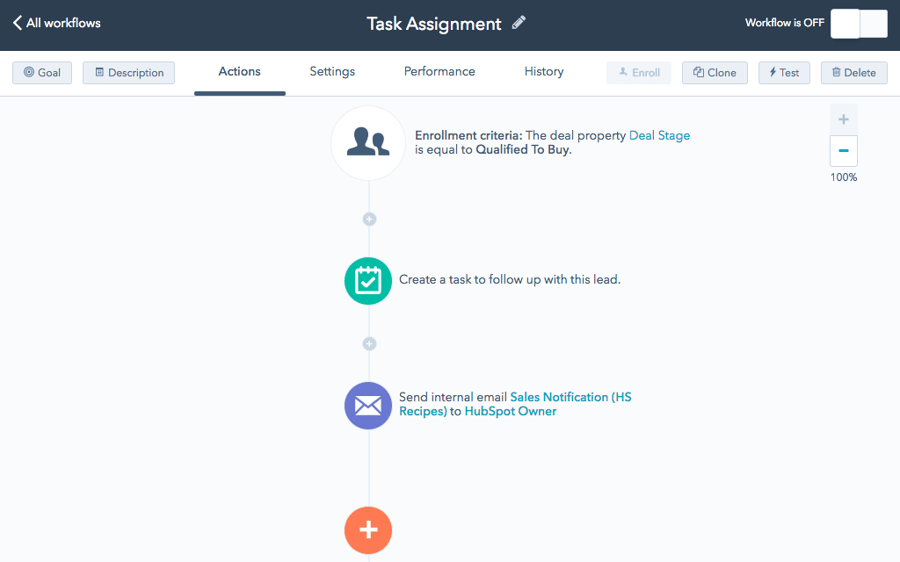INDUSTRIAL MANUFACTURERS
Leveraging Inbound Sales Methodologies and Sales Enablement to Work More Efficiently
It’s no secret that the days of cold calling are over. Data-driven decision making is paramount for customers as well as Sales and Marketing teams pursuing those customers.

Table Of Contents
What is Inbound Sales for Industrial Manufacturing?
Industrial manufacturers are understanding the importance of attracting, engaging, and winning customers based on context as much as need, and fueling relationships with relevant content and timely touchpoints.
It’s all part of inbound marketing and sales. Building a program around these proven methodologies and powerful sales enablement tools is garnering results.
The Inbound Sales Methodology
Before the advent of the Internet, salespeople were essential to the buying/selling process because they were the only ones who could answer prospects’ questions. Today, the information buyers need to make a purchase decision is just a click away – representing a significant shift in power from seller to buyer.
The shift may partially explain why online engagement is the last point of influence for 57% of industrial manufacturers. Many sellers don’t take the following into consideration:
- 90% of B2B buyers use online search tools specifically to research business purchases
- Buyers have completed nearly 70% of the buying process before they ever identify themselves to a sales representative
- Buyers conduct an average of 12 product-related searches before ever engaging on any particular company’s website
These statistics reflect a new reality: salespeople are increasingly cut out of the majority of a prospect’s buying process, making it very difficult to influence purchase decisions.
That’s why smart organizations are implementing an Inbound Sales approach to engage their best prospects. This methodology focuses on the buyer–not the seller–with a sales process that’s personalized to the buyer’s context.
Inbound Sales is comprised of four stages: Identify, Connect, Explore and Advise
Identify
By engaging with marketing content or by directly reaching out to a sales representative, a prospect essentially “raises his or her hand” and self-identifies as a potential buyer. Inbound Sales lets you know if and when a lead is active in the buying process, reducing or eliminating the need for cold calls. Prioritizing inbound leads makes sales contact more effective, welcomed and even expected by potential buyers.
Connect
Lead nurturing is a key component in the Connect phase since your Marketing team develops and provides useful content so leads can evaluate the information and answer their own questions.
Traditional/legacy salespeople have a standard elevator pitch they deliver to everyone. Not surprisingly, this generic approach usually results in poor response rates, no meetings set, and lots of wasted time.
With Inbound Sales, you connect with a prospect by personalizing a message to their specific context–something you’re able to do because you know what they’ve downloaded, what pages of the site they’ve visited, how they’ve answered key questions on forms on your site, how frequently they are visiting, etc.
Moreover, you connect with a disciplined approach called a Connect Attempt Sequence once the data reflects the lead is likely to engage in the sales process.

How Social Selling Fits into the Connect Phase of Inbound Sales
Social selling, not to be confused with social media marketing, is the process of using social media to develop relationships as part of the sales process. With buyers spending more time online researching their purchases, they’re influenced by the content they see on social media and the people with whom they’re connected. For salespeople, this provides opportunities to keep buyers informed, address pain points, maintain contact throughout a long sales process, keep your company top-of-mind, and much more.
B2B sales is no longer a phone and email game. LinkedIn is an important soft-touch selling tool for industrial manufacturers that, when combined with the right LinkedIn social selling tactics, allow sales reps to better engage their prospects.
Explore
By the time you reach the Explore phase of Inbound Sales, you’ve identified and connected with a lead and know that further conversation is warranted to determine if the partnership would be a good fit.
The Explore phase results in one of three potential outcomes:
- Determine it’s a fit and get buy-in for next steps
- Determine it will never be a fit
- Determine it’s not a fit right now
Tools like BANT and GPCT will help you uncover if a prospect is ready to move to the Advise stage of the Inbound Sales process. There’s no shame in disqualifying a lead early in this process. In fact, it’s valuable. Inbound sales people avoid spending time with prospects who won’t move forward–time they can redirect towards finding and helping buyers who need and want assistance.
Advise
The Advise phase of Inbound Sales essentially equates to the “close” stage. However, instead of a salesperson focusing on making a sale, they’re focused on personalizing the approach and solution to the buyer’s context, ultimately confirming that what is offered aligns with what’s needed.
The ideal outcome at the conclusion of the Advise phase is, of course, a sale. A strong sales proposal will close the deal. There are nuances with all industries and companies that will shape the format and flow of a sales proposal. Getting input from both Sales and Marketing to determine what your essential pieces are goes a long way to preparing and leveraging a winning sales proposal template.
Legacy v. Inbound Sales
With customer-centric selling comes a notable shift away from legacy sales, redefining the role of salespeople.
Legacy Salespeople
- Are unaware of which buyers are active in a buying journey
- Use cold outreach; lead with generic elevator pitch to qualify on budget
- Transition into presentation mode when a buyer expresses interest
- Deliver the same presentation every time and offer discounts to get buyers to purchase on seller’s timeline
Inbound Salespeople
- Prioritize buyers that are active in a buying journey
- Build trust by participating in the buyer’s online conversations; lead with personalized messaging and advice based on buyer’s interests
- Transition into exploration mode when a buyer expresses interest
- Personalize the presentation to each buyer and adjust sales process to the buyer’s timeline
The pivot away from legacy sales supports the identify-connect-explore-advise path of the inbound methodology, and also demonstrates how the methodology mirrors the buyer’s journey.
Awareness, Consideration, Decision
Instead of navigating through the sales process built around the sales team’s needs, inbound flips the script. It redefines the process from the buyer’s perspective, and provides opportunities for salespeople to truly add value.
It’s a matter of understanding the buyer’s world through a three-part buyer’s journey of awareness-consideration-decision:
Awareness
In this stage, buyers identify a challenge to solve or idea to investigate and determine if they want to pursue it. Proactively asking these questions puts sales teams in a good position to respond to buyers in the Awareness stage:
- How do the buyers describe their pain points or ideas? How does our product/service alleviate their concerns or help them implement the idea?
- How can I assist buyers in learning more about their challenge/idea?
- How can we influence a buyer’s decision in how/when/why to prioritize addressing the issue?
Consideration
During the consideration stage, buyers are committed to solving their challenge or acting on an idea, and focused on different approaches or methods to do so. A buyer’s consideration stage is best understood by asking:
- What are buyers looking for/at as a solution?
- How do buyers categorize possible solutions? Pros? Cons?
- What makes our product/service different/better/ideal?
Decision
In the decision stage, buyers have decided on a solution. They narrow their list of offerings and vendors, cross-comparing each to determine what and who best meets their needs. The rubber meets the road in this stage, so it’s critical to drill into these areas:
- What offerings does a buyer typically evaluate?
- What evaluative criteria does a buyer use?
- What makes our product/service qualitatively different from competitors?
- Who is involved in the decision making process? How does each stakeholder look at the situation and weigh solutions?
What About Requests For Proposals(RFPs)?
Requests for a Proposal (RFPs) are common for soliciting bids on projects in complex industries, and the inbound sales methodology provides three approaches for handling them:
- Develop content/offers that establish RFP authority. When a buyer is faced with developing an RFP within your industry, they may well turn to the internet for advice on how to do so effectively. That’s your opportunity to step in as an “RFP co-conspirator” by proactively providing the answers they seek. It may take the form of content that directly addresses the issue, such as a “How to Do an RFP for X Industry.” Or, seize the chance to connect by offering a free RFP consultation request.
- Subvert the RFP process altogether. RFPs are commonly used, but they aren’t suited to all industries or all types of purchases. If you receive an RFP, don’t hesitate to subvert the process to help put your company on the short list of vendor contenders, if not win the business outright. Reach out to the prospect directly and have a meaningful conversation about their needs. Take the time to listen, understand, and offer suggestions. Often, it is in these exchanges that prospects gain more clarity about what they want and you can better determine how your product or service serves as a solution.
- Use inbound lead scoring to identify RFP opportunities worth pursuing. It’s tempting and sometimes all too easy to fall into the trap of responding to every RFP you receive. After all, the prospect is sending a clear signal they are in a position to purchase. The truth is, habitually chasing every opportunity will leave you with little to show for your efforts. RFP responses are time consuming and often expensive, so be selective about pursuit. Inbound lead scoring — a points-based system for ranking potential customers — gives you insight into which RFPs to prioritizes.
Discover the power of leveraging the inbound sales methodology:
Sales & Marketing ALIGNMENT
When it comes to how prospects are nurtured and when they’re contacted, if Sales is working on one set of assumptions and Marketing is using another, the plan is fundamentally broken. As a result, Sales and Marketing departments often find themselves working at cross-purposes instead of joining forces to succeed.
A set of “rules” is needed that clearly identifies what each part of the team is responsible for, what actions are taken (and when), and how a prospect is brought in, as explored in this video:
The Role of The Service Level Agreement (SLA)
A Service Level Agreement (SLA) breaks down the complex B2B process of inbound lead generation and sales so that everyone involved in business development has a clear and deliberate plan. This can also help shorten your B2B sales cycle. No more unknown or assumed expectations between departments or team members, no more wasted effort in pursuing low-value leads, and no more process confusion.
Today, many only strongly agree/agree that they have excellent alignment between Marketing and Sales, signaling definite room for improvement. It also underscores the importance of creating a successful service level agreement (SLA) between the teams to alleviate process confusion and assumed expectations.
There are 7 key components to creating a successful SLA:
- State your shared goal, buyer personas, and buyer journeys
- Agree on definition of qualified leads
- Determine how to qualify leads, what parameters need to be set
- Define what triggers lead handoff from Marketing to Sales and how the handoff occurs
- Delineate how leads will be nurtured during each stage of the prospect’s journey
- Outline how Sales will handle incoming leads
- Identify Key Performance Indicators (KPIs) for both Marketing and Sales
Lead Qualification
Not every lead that is gathered is appropriate for immediate pursuit by the sales team. There are marketing qualified leads (MQLs) with the potential to become customers if led through the proper nurturing, and sales qualified leads (SQLs) that are vetted by Marketing and ready for engagement with Sales.
Once fit and readiness are determined, it’s time for the lead handoff from Marketing to Sales. Transitioning from MQL to SQL requires focused attention, as leads are vulnerable during this time. Your CRM and marketing platform should improve the lead handoff process from Sales to Marketing and vice versa. Transparency between Sales and Marketing with one shared platform arms each side with information to streamline efforts and increase productivity.

Closed Loop Reporting
Track business performance throughout the Marketing and Sales funnel with integrated data tracking of each visitor and lead, from their first web visit to lead conversion and sales activity.
Using sales enablement technology and automation (see below) to gather data makes for timely reporting and decision making. Having relevant information readily available to Sales and Marketing also builds in internal department and collaborative accountability that fosters improved ROI.
Read up on the roles of Sales and Marketing in lead generation, nurturing, and conversion:
WHAT IS SALES ENABLEMENT?
In order to align your marketing and sales teams, your sales team needs to be equipped to be as productive as possible – and to do their best work possible by creating targeted, personalized experiences for prospects.
In short, sales enablement is the iterative process of providing your sales team with the tools, content, and processes required to sell more effectively, more efficiently, and faster than they could without them. Further, it promotes collaboration and solidifies alignment between sales and marketing.
Sales Enablement Essentials
For sales teams working within an inbound marketing structure, being as productive as possible encompasses:
- Tools such as websites, customer relationship management (CRM), sales engagement automation platforms, and content management software (CMS) that help salespeople track and assist leads as they move through the buyer journey (See Sales Enablement Software: Technology and Automation, below)
- Content that truly meets the needs of the customer. It is in content creation that sales and marketing alignment really shines. Salespeople are customer experts. Combining their knowledge of customer pain points, aspirations, and needs with marketing know-how in generating content that attracts, engages, and delights at the appropriate buyer journey stages creates relevancy that resonates with leads
- Processes that clearly delineate roles, responsibilities, and accountability within and between sales and marketing teams regarding key areas such as lead scoring and management
Explore how and why sales enablement drives processes, value, and results:
Sales Enablement Software: Technology and Automation
Sales enablement software removes guesswork through automation. Having accurate data provides better control over lead nurturing, buyer’s journey paths, and ultimately customer procurement and retention.
Customer Relationship Management (CRM)
Knowing how your customers interact with your company (via purchases, service interactions, or engagement with your online content) is vital to nurturing those relationships and increasing sales. Knowing as much as you can about a customer’s or prospect’s tendencies and history with your organization can help you determine what steps to take next to close a deal, improve user experience, or increase customer loyalty.
A CRM system provides a centralized place where all these interactions are recorded, enabling you to analyze and make sense of the data, recognize and react to sales and service opportunities, enhance customer relationships, and improve customer lifetime value (CLV).
CRM systems are often stand-alone software platforms, sometimes proprietary to an industry or even just one organization. But they can also be fully integrated with a marketing automation, sales enablement, and CMS platform, as is the case with HubSpot.
HubSpot Sales Hub
Finding a way to unify all CRM tools can be frustrating and time consuming — meaning they aren’t used to their best advantage by either Sales or Marketing. Tools that are ineffective are impediments to progress.
HubSpot Sales Hub integrates tools and data into one CRM platform that is easy to use and puts focus back on customers. Sales and Marketing are set up for success with one CRM to access and manage contacts, emails, calls, deals, and other key communications.
With HubSpot Sales Hub, time is spent understanding context about the people and companies being pursued in order to build valuable touchpoints that allow for:
- Timely conversations
- Deeper, more meaningful relationship building
- Better pipeline management
- More efficient connectivity
Shared Lead Intelligence
The smart use of a CRM platform means that everybody involved has accurate and useful information, ensuring more productive initial contact and subsequent conversations than cold calls.











.jpg?width=1240&height=630&name=sales%20enablement%20(1).jpg)



